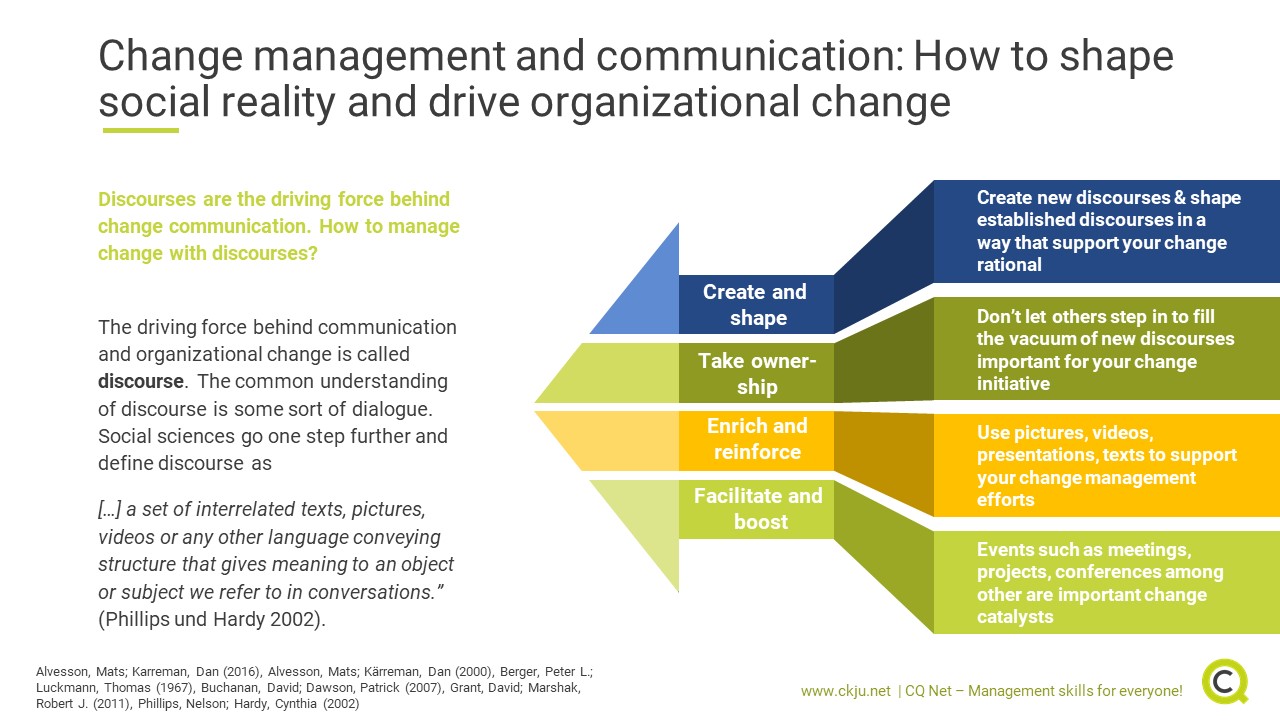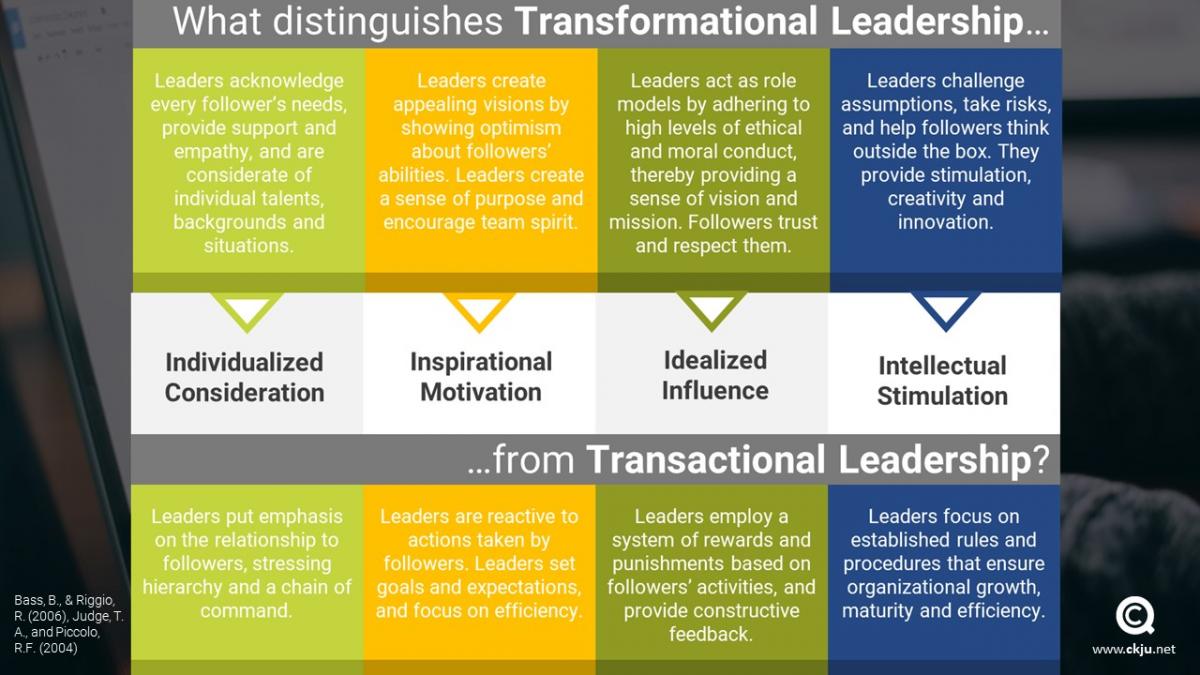- All Management Learning Resources
- Organizational transformation

Executive summary
In your professional live you will most certainly face situations were only an organizational transformation can move you and your organization out of harm's way. New regulatory frameworks, disruptive innovations, financial crisis are some examples of events where gradual or incremental change reaches its limits. The same applies when you want to develop your organization to the next performance level (Waclawski 2002). There are many learning and development interventions on individual and team level (Shuffler et al. 2011). However, from time to time you will need to consider an organizational transformation to increase competitiveness. In this CQ Dossier we will have a look at how you can manage an organizational transformation with tools based on high-end knowledge from theory and research.
Contents
- Executive summary
- Language and negotiation of meaning play a crucial role in organizational transformations
- Build and construct your organization’s future (=strategy) state with your key stakeholders
- Use language that facilitates your organizational transformation
- Spark the fire: Motivation as change catalyst for organizational transformation
- Leadership matters. Which approach is most appropriate depends on situation and context
- Key take-aways
- References and further reading
Language and negotiation of meaning play a crucial role in organizational transformations
Social sciences have started to turn their attention to language and negotiation of meaning as playing a crucial role in organizational change. The rationale behind this linguistic turn (Alvesson und Kärreman 2000) is the assumption that social reality is the results of ongoing negotiation processes taking place in- and outside an organization. Some organizational scholars go even one step further and argue that organizations itself are the result of processes of social construction as they only exist in narratives, documents and memory traces (Cardellini 2006). We will have a look at change interventions that rely on this understanding of social reality and change in this CQ Dossier.
Build and construct your organization’s future (=strategy) state with your key stakeholders
Social reality in organizations is not given or determined but negotiated. This has far reaching implications for your organizational transformation. Instead of telling people where you want to have the organization changed, you need to build and construct the desired future state with your key stakeholders. Future state refers in this context to a shared understanding of your organization’s future characteristics after the transformation took place. Thus, the term future state can be understood as a placeholder for more commonly used business terms such as strategy, mission, vision, strategic targets etc. We will use the term strategy and future state interchangeably.
Strategy is a practice rather than something organizations have
Developing a future state that characterizes your organization after the transformation involves a considerable amount of communication, discussion and involvement until you manage to create a “multi-authored” (Buchanan und Dawson 2007) picture that both you and your stakeholders embrace. You can achieve this for instance in strategy workshops (Jarzabkowski und Seidl 2008) where the shared understanding of your organization’s future state is addressed and shaped.
However, it is not just strategy meetings (which can be considered a Field Configuring Event) where the future state of your organization and thus its change trajectory is defined. Recent insights from strategy research have brought to light that strategy can also be seen a practice (Whittington 2006) rather than something organizations have. Thus, developing and communicating it is just the start. In order to create and maintain the desired change momentum you need to continuously address the future state, listen to concerns related to it and empower your teams to take ownership in implementing it.
Use language that facilitates your organizational transformation
One of our main intervention tool to foster change in your organization is language. Language use also involves written language, pictures, videos, e-mails etc. Your task in now to make sense of the change intervention in daily business. This is particularly important for an organizational transformation, as they also involve a shift of your organization’s identity. You can for instance offer a bridge from your current organization’s identity to the future one. Assumed your organization has a strong track record in product innovations, you could connect this “being innovative” identity discourse to a desired future state defined by “develop new products”.
Combine top-down and bottom-up change interventions
Consistency and legitimacy play also a crucial role in organizational transformations as language use is closely connected to the application of power (Fairclough 2014). Don’t play the top down game and tell people what they should do (which is a direct application of position power) but offer them a reason why it is important for the organization to change.
Stay consistent with your change rational and the way you communicate it
Organizational change doesn't happen overnight. This especially applies to a massive organizational transformation. Even though it sounds weird, an organizational transformation requires stability. Stability refers to a consistent change rational that is communicated on a regular and frequent basis via a set of communication channels. Changing human attitudes and perspectives takes time. Having a consistent argument why change has to take place it the very basis to make it happen.
Spark the fire: Motivation as change catalyst for organizational transformation
Motivation is the invisible force that makes people move. Thus, motivation is an important lever you should take into consideration in any organizational transformation. You are wondering how to increase your employee’s motivation to change? Self Determination Theory (SDT) and goal setting theory provide well proven frameworks you can rely on when conducting a change intervention.
Foster the basic psychological needs autonomy, competence and relatedness
SDT is built on the foundation that autonomy, competence and relatedness are basic psychological needs every individual is striving for (Broeck et al. 2010). When you provide your employees a workplace context that supports these needs, they will tend to support the transformation rather than opposing it (Deci et al. 2017). This could involve being supportive in terms of problem solving, providing a rational for the change initiative and listening to your employees’ perspectives and concerns.
Management skills newsletter
Join our monthly newsletter to receive management tips, tricks and insights directly into your inbox!
Formulate and commit specific, challenging but achievable goals with your team
There is considerable evidence that specific, challenging but achievable goals in combination with regular performance feedback increase motivation (Locke und Latham 2016). In addition, goals should be relevant for individuals, teams and the entire organization. In combination with a supportive environment such goals satisfy above mentioned basic psychological needs. As a consequence, your employees autonomous motivation is going to increase which has a positive impact on performance and wellbeing (Deci et al. 2017).
Leadership matters. Which approach is most appropriate depends on situation and context
Taking all this into consideration you might wonder what role leadership plays in organizational transformations. While the answer to the question is a clear “leadership matters”, the connection between change and leadership is not as straightforward as you might expect. There is a variety of leadership approaches available, but none of them is a silver bullet for successful organizational transformations. It is up to you to select the most appropriate leadership style for the specific situation and context. We have a look at some of them and how they help you to go through an organizational transformation.
Transformational leadership makes a visionary leader
For instance, transformational leadership has been connected to successful change projects and is defined by the four main behaviors idealized influence, individualized consideration, inspirational motivation and intellectual stimulation (e.g. Chou 2014). The assumption behind transformational leadership is that these four behaviors make a visionary leader who develops his followers to a higher performance level. Transformational leadership is usually contrasted to transactional leadership which is mostly about managing deviations and exceptions. However, there are most properly times when managing deviations is exactly what you need. Thus, you should be familiar with both leadership approaches.
It is not just senior management that leads change but every single employee
The traditional understanding of leadership is based on the assumption that there is a team of senior managers which is formally leading the organization. This might be right from a legal perspective. However, from a change perspective recent research tells another story. Distributed leadership (Buchanan et al. 2016), change agents and middle management (Rouleau und Balogun 2011) get more and more attention as critical success factors for managing change. This opens up the opportunity for a more holistic understanding of leadership. Ask your employees how they lead and support the change initiative. Empower your middle managers to come up with solutions on how to implement the required changes in their area of responsibility.
Agility and agile leadership is an enabler for organizational transformations
An organizational transformation can only succeed when two prerequisites are met:
- The need for change is recognized early enough which requires having a good understanding of the "organization-environment" fit as well as market trends and regulatory changes.
- The structures and processes of the organization can be adjusted fast enough to meet the new requirements in terms of business models, market trends, and regulatory frameworks.
Agility and agile leadership is a holistic framework that helps to navigate an environment that is characterized by a high level of volatility, uncertainty, complexity and ambiguity (VUCA). When implemented in the right way, an agile organization is not just capable of recognizing the need to change very quickly but can also adjust its processes and structures much faster than traditional organizations can do.
Organizational transformations are complex endeavors that cannot be managed with a receipt like top-down management approach. This CQ Dossier summarizes most recent research insights into how to manage an organizational transformation. Beside taking scientific evidence into consideration, you should also involve context specific evidence such as data, stakeholder expectations and your own any your peers experience in your decision making process.
Key take-aways
- Language and negotiation of meaning play a crucial role in large scale change interventions
- Build and construct your organization’s future state with your key stakeholders
- Strategy is an ongoing practice rather than something organizations have
- Use language that facilitates your change intervention (e.g. by drawing on positive discourses)
- Motivation can be a powerful change catalyst
- Leadership matters. Which approach is most appropriate depends on situation and context
- It is not just senior management that leads change but every single employee
References and further reading
Alvesson, Mats; Kärreman, Dan (2000): Taking the Linguistic Turn in Organizational Research. In: The Journal of Applied Behavioral Science 36 (2), S. 136–158. DOI: 10.1177/0021886300362002.
Broeck, Anja; Vansteenkiste, Maarten; Witte, Hans; Soenens, Bart; Lens, Willy (2010): Capturing autonomy, competence, and relatedness at work. Construction and initial validation of the Work-related Basic Need Satisfaction scale. In: Journal of Occupational and Organizational Psychology 83 (4), S. 981–1002. DOI: 10.1348/096317909X481382.
Buchanan, David; Dawson, Patrick (2007): Discourse and Audience. Organizational Change as Multi-Story Process. In: J Management Studies 44 (5), S. 669–686. DOI: 10.1111/j.1467-6486.2006.00669.x.
Buchanan, David A.; Addicott, Rachael; Fitzgerald, Louise; Ferlie, Ewan; Baeza, Juan I. (2016): Nobody in charge. Distributed change agency in healthcare. In: Human Relations 60 (7), S. 1065–1090. DOI: 10.1177/0018726707081158.
Cardellini, Liberato (2006): The Foundations of Radical Constructivism. An Interview with Ernst von Glasersfeld. In: Found Chem 8 (2), S. 177–187. DOI: 10.1007/s10698-006-9012-z.
Chou, Paul (2014): Does Transformational Leadership matter during Organizational Change? In: EJSD 3 (3), S. 49–62. DOI: 10.14207/ejsd.2014.v3n3p49.
Deci, Edward L.; Olafsen, Anja H.; Ryan, Richard M. (2017): Self-Determination Theory in Work Organizations. The State of a Science. In: Annu. Rev. Organ. Psychol. Organ. Behav. 4 (1), S. 19–43. DOI: 10.1146/annurev-orgpsych-032516-113108.
Fairclough, Norman (2014): Language and power. Third edition. London, New York: Routledge Taylor & Francis Group.
Jarzabkowski, Paula; Seidl, David (2008): The Role of Meetings in the Social Practice of Strategy. In: Organization Studies 29 (11), S. 1391–1426. DOI: 10.1177/0170840608096388.
Locke, Edwin A.; Latham, Gary P. (2016): New Directions in Goal-Setting Theory. In: Curr Dir Psychol Sci 15 (5), S. 265–268. DOI: 10.1111/j.1467-8721.2006.00449.x.
Rouleau, Linda; Balogun, Julia (2011): Middle Managers, Strategic Sensemaking, and Discursive Competence. In: Journal of Management Studies 48 (5), S. 953–983. DOI: 10.1111/j.1467-6486.2010.00941.x.
Shuffler, Marissa L.; DiazGranados, Deborah; Salas, Eduardo (2011): There’s a Science for That. In: Curr Dir Psychol Sci 20 (6), S. 365–372. DOI: 10.1177/0963721411422054.
Waclawski, Janine (2002): Large-scale organizational change and performance. An empirical examination. In: Human Resource Development Quarterly 13 (3), S. 289–305. DOI: 10.1002/hrdq.1032.
Whittington, Richard (2006): Completing the Practice Turn in Strategy Research. In: Organization Studies 27 (5), S. 613–634. DOI: 10.1177/0170840606064101.
About the Author





